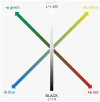The effect of constitutive pigmentation on the measured emissivity of human skin
- PMID: 33237918
- PMCID: PMC7688144
- DOI: 10.1371/journal.pone.0241843
The effect of constitutive pigmentation on the measured emissivity of human skin
Abstract
Background: The measurement of body temperature has become commonplace in the current COVID-19 pandemic. Body temperature can be measured using thermal infrared imaging, a safe, non-contact method that relies on the emissivity of the skin being known to provide accurate readings. Skin pigmentation affects the absorption of visible light and enables us to see variations in skin colour. Pigmentation may also affect the absorption of infrared radiation and thus affect thermal imaging. Human skin has an accepted emissivity of 0.98 but the effect of different skin pigmentation on this value is not known. In this study, we investigated the influence of different skin pigmentation on thermal emissivity in 65 adult volunteers.
Methods: A reference object of known emissivity (electrical tape) was applied to participant's skin on the inner upper arm. Tape and arm were imaged simultaneously using a thermal infrared camera. The emissivity was set on the camera to the known value for electrical tape. The emissivity was altered manually until the skin temperature using thermal imaging software was equal to the initial tape temperature. This provided the calculated emissivity value of the skin. Participants were grouped according to skin pigmentation, quantified using the Fitzpatrick skin phototyping scale and reflectance spectrophotometry. Differences in emissivity values between skin pigmentation groups were assessed by one-way ANOVA.
Results: The mean calculated emissivity for the 65 participants was 0.972 (range 0.96-0.99). No significant differences in emissivity were observed between participants when grouped by skin pigmentation according to the Fitzpatrick scale (p = 0.859) or reflectance spectrophotometry (p = 0.346).
Conclusion: These data suggest that skin pigmentation does not affect thermal emissivity measurement of skin temperature using thermal infrared imaging. This study will aid further research into the application of thermal infrared imaging as a screening or bedside diagnostic tool in clinical practice.
Conflict of interest statement
The authors have declared that no competing interests exist.
Figures
Similar articles
-
Infrared camera assessment of skin surface temperature--effect of emissivity.Phys Med. 2013 Nov;29(6):583-91. doi: 10.1016/j.ejmp.2012.09.003. Epub 2012 Oct 18. Phys Med. 2013. PMID: 23084004
-
An instantaneous approach for determining the infrared emissivity of swine surface and the influencing factors.J Therm Biol. 2016 Apr;57:78-83. doi: 10.1016/j.jtherbio.2016.03.003. Epub 2016 Mar 9. J Therm Biol. 2016. PMID: 27033042
-
Enhanced thermal imaging of wound tissue for better clinical decision making.Physiol Meas. 2017 Jun;38(6):1104-1115. doi: 10.1088/1361-6579/aa6ea0. Epub 2017 Apr 21. Physiol Meas. 2017. PMID: 28430667
-
[Contemporary applications of infrared imaging in medical diagnostics].Ann Acad Med Stetin. 2006;52(1):35-9; discussion 39-40. Ann Acad Med Stetin. 2006. PMID: 17131845 Review. Polish.
-
Recent use of medical infrared thermography in skin neoplasms.Skin Res Technol. 2018 Nov;24(4):587-591. doi: 10.1111/srt.12469. Epub 2018 Mar 25. Skin Res Technol. 2018. PMID: 29575378 Review.
Cited by
-
Water retention influences thigh skin temperature variation post-exercise: preliminary study of bioimpedance analysis and thermography data.Front Sports Act Living. 2025 Feb 14;7:1516570. doi: 10.3389/fspor.2025.1516570. eCollection 2025. Front Sports Act Living. 2025. PMID: 40027096 Free PMC article.
-
A comprehensive numerical procedure for high-intensity focused ultrasound ablation of breast tumour on an anatomically realistic breast phantom.PLoS One. 2024 Oct 1;19(10):e0310899. doi: 10.1371/journal.pone.0310899. eCollection 2024. PLoS One. 2024. PMID: 39352893 Free PMC article.
-
Temperature thresholds and screening of febrile people by non-contact measurement of the face using infrared thermography - A methodology proposal.Sens Biosensing Res. 2022 Aug;37:100513. doi: 10.1016/j.sbsr.2022.100513. Epub 2022 Aug 6. Sens Biosensing Res. 2022. PMID: 35958188 Free PMC article.
-
Numerical study of magnetic hyperthermia ablation of breast tumor on an anatomically realistic breast phantom.PLoS One. 2022 Sep 21;17(9):e0274801. doi: 10.1371/journal.pone.0274801. eCollection 2022. PLoS One. 2022. PMID: 36129953 Free PMC article.
-
A Comparative Study of Forehead Temperature and Core Body Temperature under Varying Ambient Temperature Conditions.Int J Environ Res Public Health. 2022 Nov 29;19(23):15883. doi: 10.3390/ijerph192315883. Int J Environ Res Public Health. 2022. PMID: 36497956 Free PMC article.
References
-
- Fernández-Cuevas I, Bouzas Marins JC, Arnáiz Lastras J, Gómez Carmona PM, Piñonosa Cano S, García-Concepción MÁ, et al. Classification of factors influencing the use of infrared thermography in humans: A review. Infrared Physics & Technology 2015;71:28–55.
Publication types
MeSH terms
LinkOut - more resources
Full Text Sources





